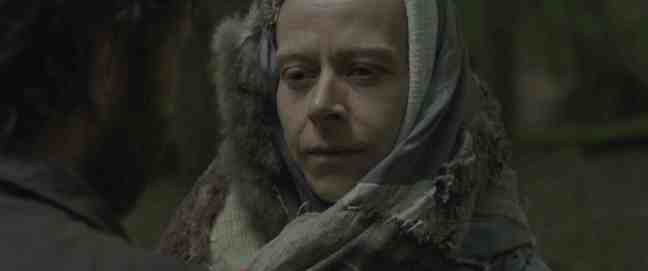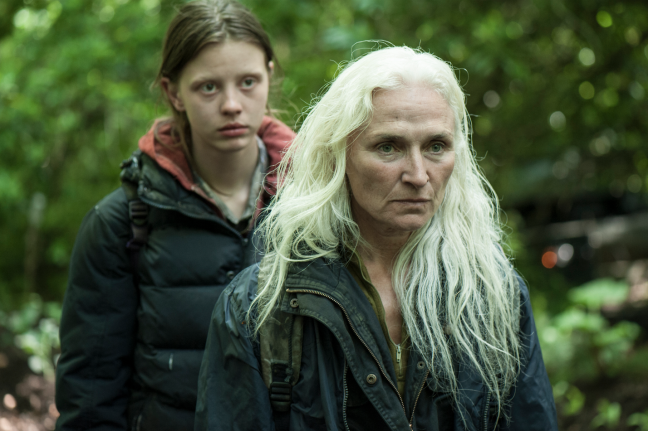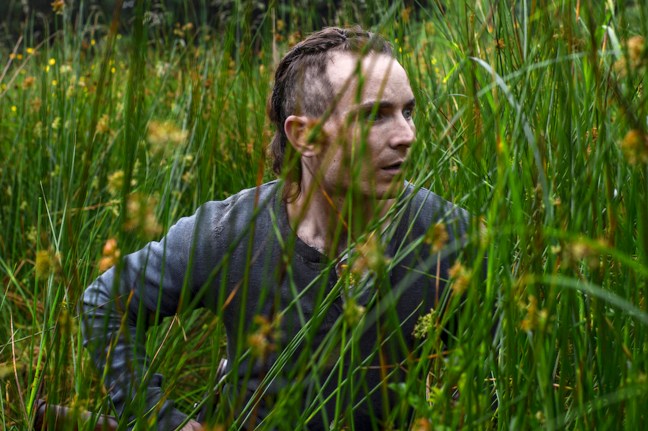Two British films at LFF stood out for depicting alternately intentional and enforced isolation. Tom Geens’ Couple in a Hole saw Scottish actors Kate Dickie and Paul Higgins as Karen and John, a couple who have decided to live just as the title suggests, in a forest in France. By contrast, but with thematic overlaps, The Survivalist directed by Stephen Fingleton and set in Northern Ireland, focuses on the attempt of one man to maintain solitude in a post-apocalyptic world. In both instances, the maintenance of isolation seems futile, as outsiders find a way to help and/or disrupt the routines of those living off the grid.
Couple in a Hole obscures the reasons behind Karen and John’s choice to dwell underground, until their routines are well established. They’ve developed roles for themselves as nurturer and hunter, where John has the responsibility of tracking, killing or gathering food for them. A collection of bugs or mushrooms is a delicious treat served on a leaf-plate. Karen however, suffers from agoraphobia, only attempting small progressions to the outside under John’s careful encouragement. This set-up is depicted by Geens as one the couple both take comfort in, and the director portrays their lush forest environment and the surrounding hills as something of a rural idyll. Sam Care’s cinematography captures the beauty of both the wide expanse of countryside and the safety of the forest enclosure.

There’s an inevitability to the way their small world becomes disturbed, due to the oddness of their circumstances. Karen and John’s living situation is so far removed from the constantly connected consumer driven one we’ve become accustomed to that it feels like our time is simply biding until ‘something’ disturbs the peace. That something is a poisonous spider bite that drives Karen screaming back into the hole after an all too fleeting moment outside her enclave. This event allows Geens’ great reveal, the sight of John venturing to a village near the forest that at once brings into focus what the couple had relinquished in order to achieve something like peace.

The events that follow John’s village excursion escalate the plot towards a conclusion more baffling than the original set up. Though there’s something a little disappointing about the eventual resolution of Couple in a Hole, its style and creativity make the film hugely enjoyable, not least of all due to the synth heavy, atmospheric score by BEAK.
The Survivalist too, has a forest setting, this time a farm built and maintained by a lone man (Martin McCann) who has gathered impressive resources to keep himself alive. Director Stephen Fingleton signifies the end of civilisation at the outset using the simple graphic of a population line on a chart drastically descending. No other information to explain the film’s set-up is given and throughout, dialogue is kept to an absolute minimum, as though conversation has become a luxury that the characters cannot afford. For the film’s first fifteen minutes, not a single line is uttered, as the routines of farming and hunting are shown alongside the suggestion that the Survivalist’s loneliness might be affecting his perception. When a woman, Kathryn (Olwen Fouéré) and her daughter Milja (Mia Goth) arrive one day seeking shelter, this suggestion of deep sadness only enhances the extreme caution with which the survivalist treats his visitors.

Quickly an exchange of sex for food is established, and Goth dismantles first impressions of her open-faced innocence by portraying Milja as someone in command of her body as commodity. What The Survivalist does well, despite the familiarity of the post-apocalyptic setting, is consistently shift the viewers allegiance to the characters. McCann’s performances allows his character to be sympathetic due to his gradual trust of his new house mates – his vulnerability is relatable – but his instincts never leave him. Milja meanwhile, emerges as the heart of the film, going to extreme lengths to protect herself in a way that makes her the character to truly invest in.
The Survivalist uses gesture, glance and sound in a convincingly efficient way to show the bareness of life for its characters. At the same time, the slippage into dreams and memories that the survivalist succumbs to at night, provides an opportunity to suggest the true darkness outside of his immediate environment, through a distortion of natural sound.
Stripping back the survival story to its essential elements – without a zombie threat as in The Walking Dead, or a family narrative as with The Road – makes The Survivalist ultimately deeply involving. Fingleton creates an atmosphere of constant threat within a tangible natural environment, and when the new stability is again demolished, the prospect of a more hopeful future provides an authentic and satisfying conclusion.


I like your review style, Harriet. Very authentic :). Would love to feature your reviews in our weekly curated email digest that goes out to thousands of people.